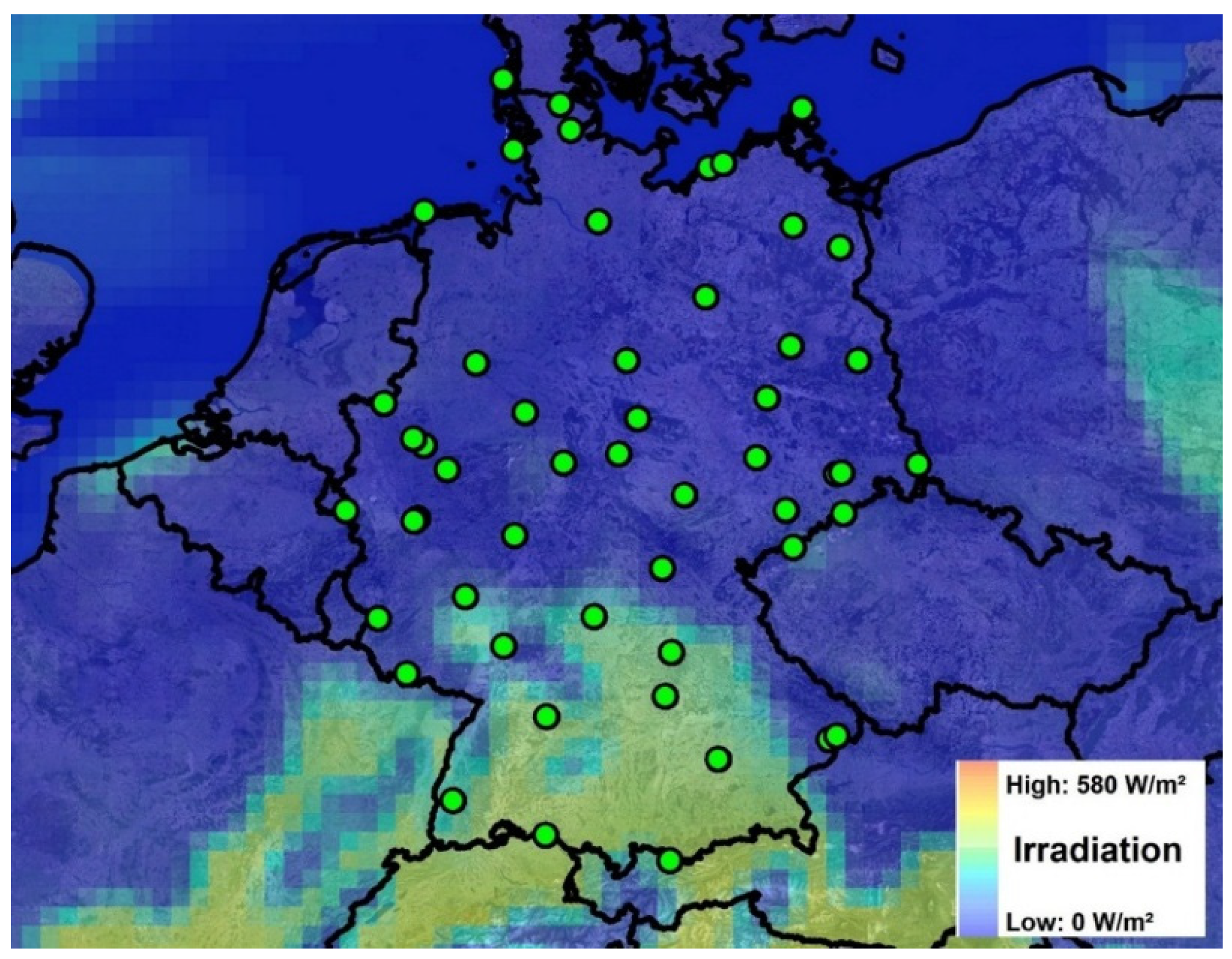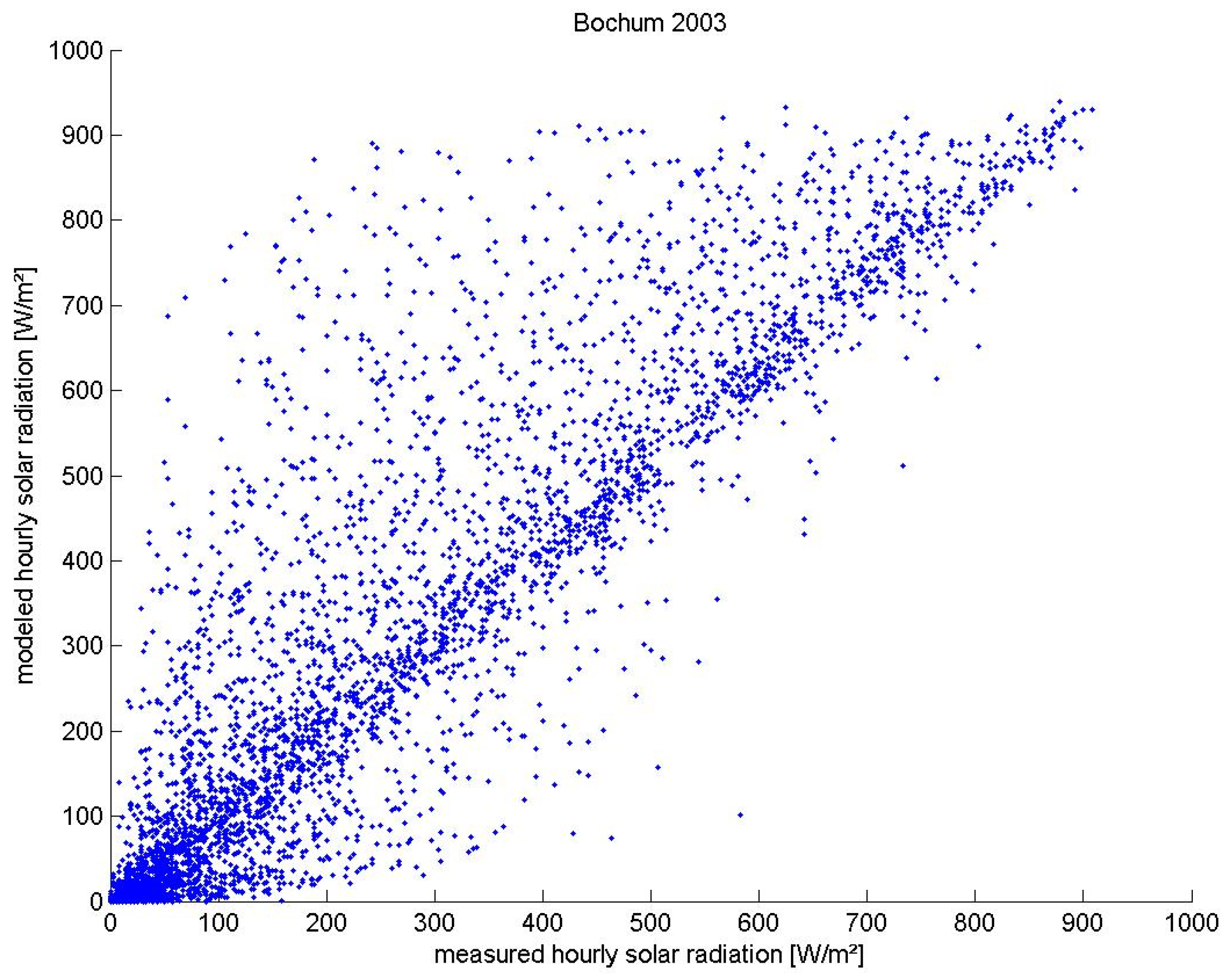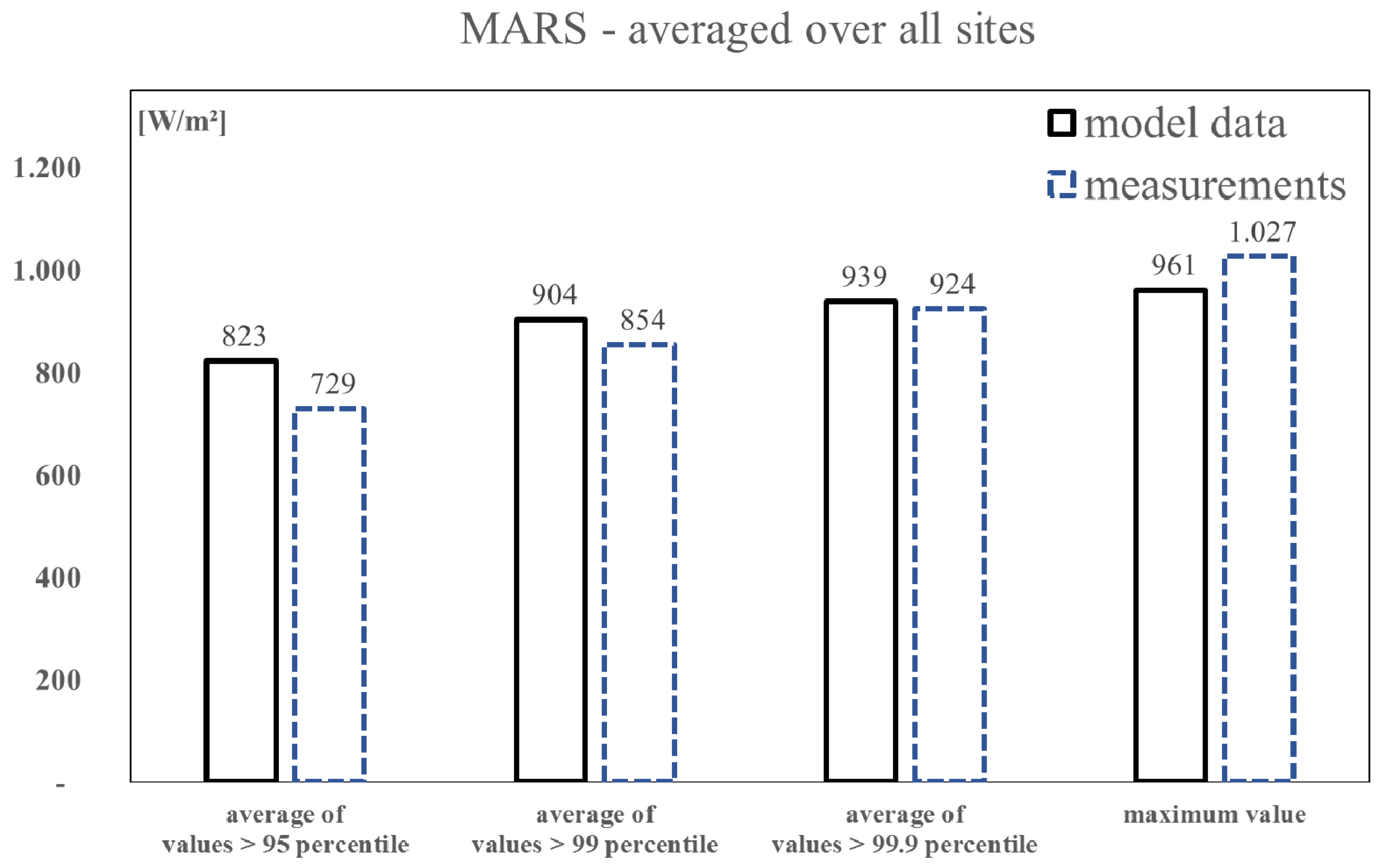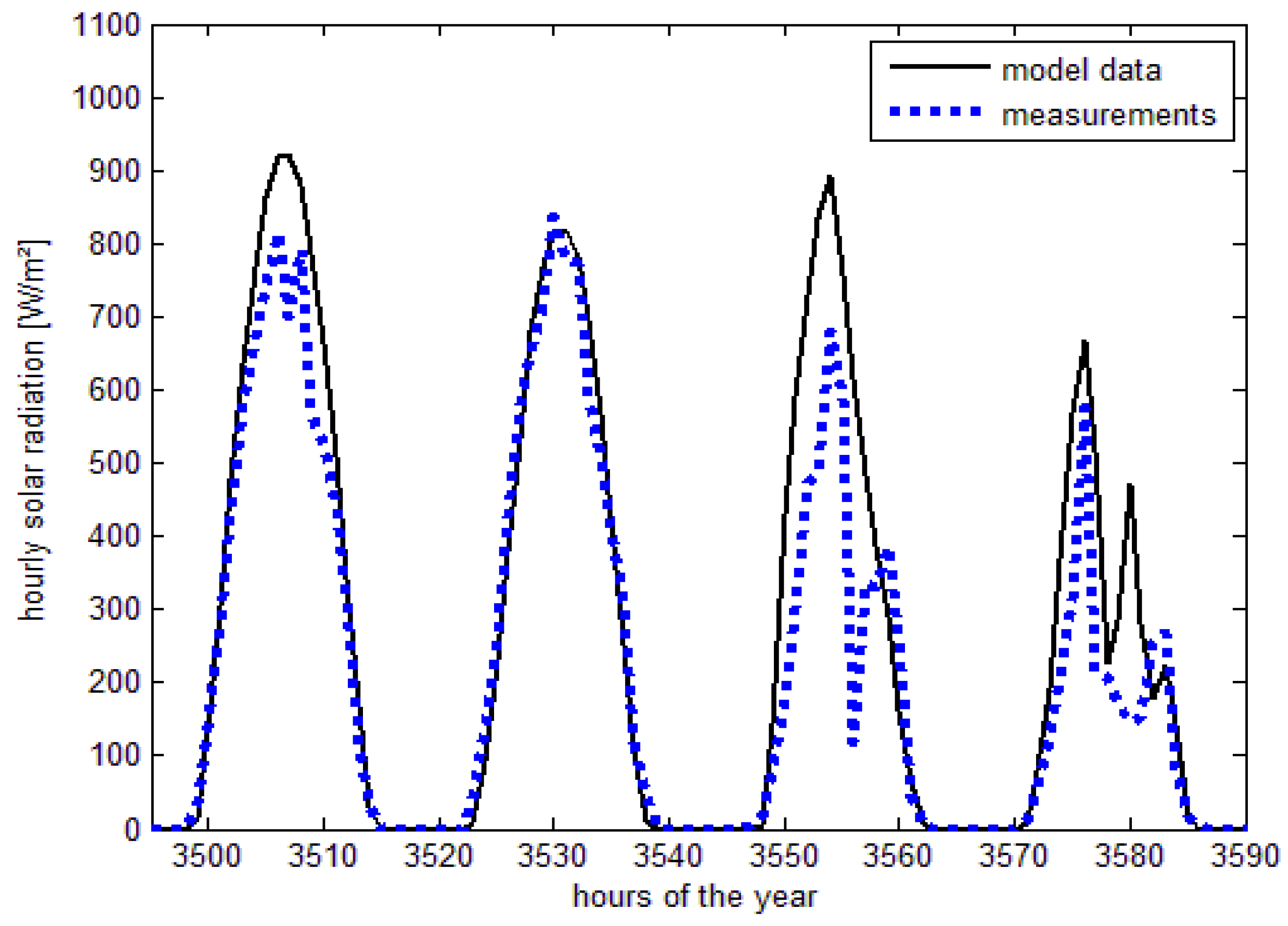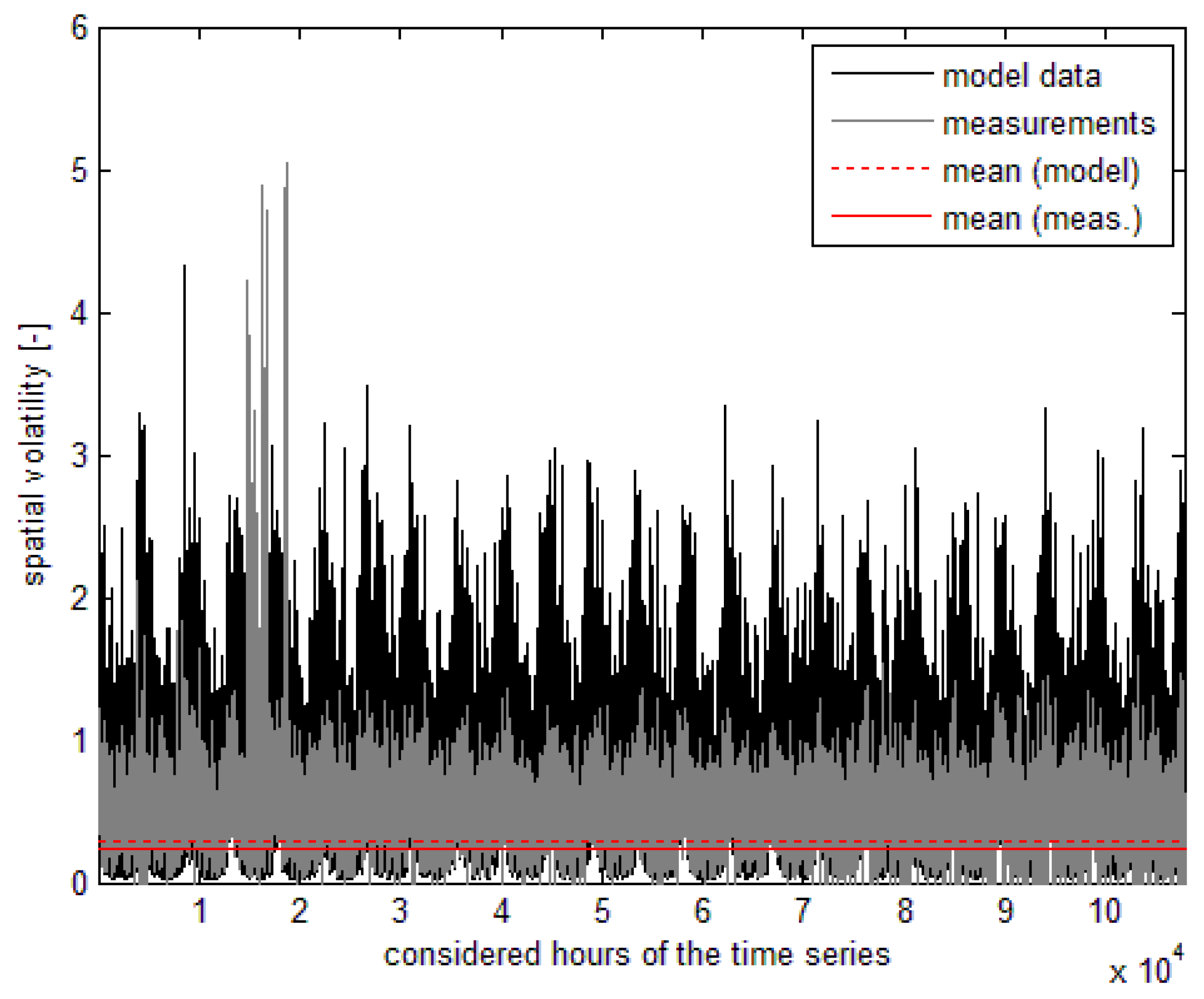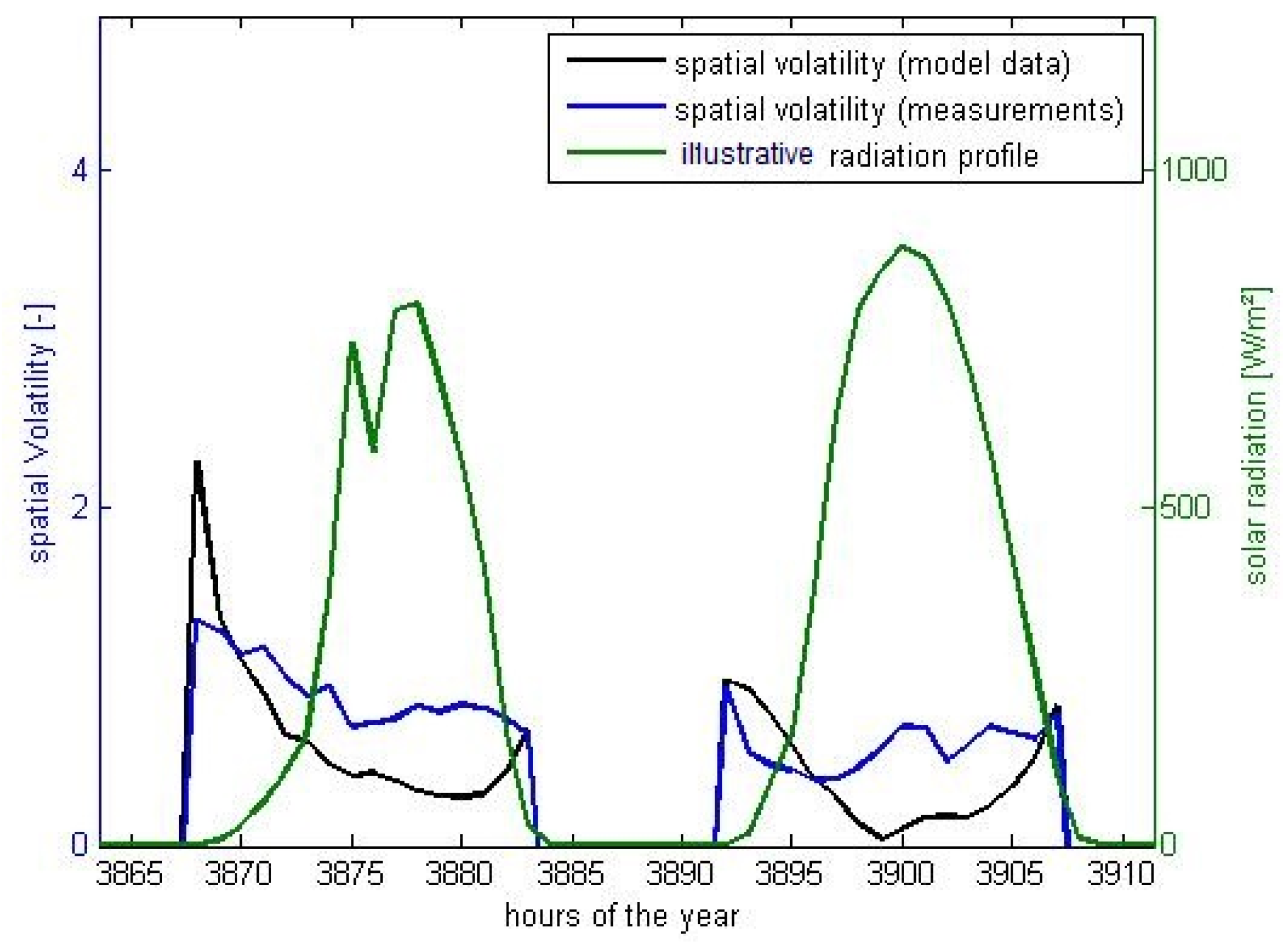4.1. MBE, RMSE and R
Regarding the MBE, calculated for each site, it becomes clear that the model data is positively biased. The averaged MBE over all locations amounts to 24.7 W/m2 per hour or 22%. This means that on average the model exceeds the measured solar irradiation supply in every hour by 24.7 W/m2. In order to express the MBE as a percentage it is normalized using the arithmetic mean of the respective measurement data sets which vary between 95 W/m2 and 132 W/m2.
The RMSE is an indicator for the scattering of data which sums up all deviations weighted to the power of two, giving more impact to high values. The respective values for the RMSE are 108 W/m2 and 11%, the relative value normalized using the range of each measurement data set.
With regard to the publications introduced in
Section 2, the MBE should be around −5% to +5% (e.g., [
7]) and the RMSE below 125 W/m
2 (e.g., [
14]) in order qualify as good results. Taking that into account, these assessment indicators do not produce a clear picture. While the high MBE implies a relative strong systematic exceedance of the irradiation model over the measurements, the RMSE appears to qualify for a good modeling performance.
Looking at the results of calculating R (
Table 1) it is noticeable that the correlation between model and measurement data is very similar for nearly all sites. Except at “Hohenpeissenberg” all correlation coefficients vary less than 5 percentage points from the mean of 90%.
Table 1.
Selected statistics for the 57 sites with measurement data available. Model data was available through 1990–2013, measurements were only available as noted in columns 1 and 2.
Table 1.
Selected statistics for the 57 sites with measurement data available. Model data was available through 1990–2013, measurements were only available as noted in columns 1 and 2.
| Measurement Available | Site | First Order Statistics |
|---|
| Start Year | End Year | MBE (W/m²) | MBE(-) | RMSE (W/m²) | RMSE (-) | R (-) |
|---|
| 1990 | 2004 | Aachen | 30.6 | 29% | 116 | 13% | 90% |
| 1990 | 2013 | Arkona | 13.3 | 12% | 90 | 10% | 93% |
| 1990 | 2006 | Bocholt | 25.9 | 24% | 108 | 11% | 91% |
| 1991 | 2013 | Bochum | 27.8 | 25% | 104 | 10% | 90% |
| 1990 | 1998 | Bonn | 30.1 | 27% | 120 | 12% | 88% |
| 1990 | 2001 | Bonn | 35.8 | 34% | 123 | 12% | 89% |
| 1990 | 2000 | Braunlage | 29.4 | 27% | 122 | 13% | 88% |
| 1990 | 2013 | Braunschweig | 25.9 | 22% | 101 | 10% | 91% |
| 1990 | 2013 | Bremen | 35.5 | 31% | 101 | 10% | 86% |
| 1990 | 2013 | Chemnitz | 24.0 | 20% | 102 | 10% | 91% |
| 1990 | 2002 | Coburg | 27.1 | 23% | 113 | 10% | 90% |
| 1990 | 1995 | Dresden | 31.1 | 26% | 111 | 12% | 91% |
| 1996 | 2013 | Dresden | 25.8 | 21% | 109 | 10% | 91% |
| 1990 | 2013 | Fichtelberg | 27.1 | 29% | 107 | 10% | 87% |
| 1990 | 1991 | Flensburg | 37.0 | 35% | 118 | 14% | 90% |
| 1990 | 2006 | Freiburg | 32.1 | 25% | 114 | 11% | 91% |
| 1997 | 2013 | Fuerstenzell | 24.2 | 18% | 106 | 10% | 92% |
| 1990 | 2013 | Geisenheim | 28.7 | 23% | 101 | 10% | 90% |
| 1990 | 1991 | Gelsenkirchen | 40.6 | 37% | 124 | 14% | 90% |
| 1990 | 2006 | Giessen | 31.7 | 28% | 114 | 11% | 91% |
| 2001 | 2013 | Goerlitz | 22.3 | 18% | 105 | 11% | 91% |
| 1990 | 1991 | Gruenow | 25.3 | 22% | 112 | 13% | 89% |
| 1990 | 2005 | Halle | 18.8 | 17% | 121 | 13% | 86% |
| 2005 | 2013 | Hamburg | 22.1 | 21% | 101 | 9% | 91% |
| 1990 | 2004 | Hamburg | 26.7 | 25% | 114 | 8% | 88% |
| 1990 | 2003 | Harzgerode | 17.7 | 15% | 122 | 11% | 86% |
| 1990 | 1997 | Heiligendamm | 21.9 | 19% | 99 | 10% | 92% |
| 1990 | 2013 | Hohenpeissenberg | 0.4 | 0.3% | 104 | 10% | 79% |
| 1990 | 2002 | Kassel | 32.3 | 30% | 118 | 12% | 90% |
| 1990 | 2013 | Konstanz | 33.7 | 26% | 101 | 10% | 92% |
| 1990 | 1990 | Leinefelde | 26.4 | 22% | 113 | 12% | 90% |
| 2006 | 2013 | Leipzig | 25.2 | 23% | 106 | 11% | 91% |
| 1990 | 2013 | Lindenberg | 20.2 | 17% | 102 | 9% | 91% |
| 1990 | 2006 | Lippspringe | 33.2 | 30% | 118 | 12% | 89% |
| 1990 | 2008 | List | 8.8 | 7% | 95 | 10% | 91% |
| 1990 | 2007 | Luedenscheid | 34.4 | 32% | 118 | 12% | 89% |
| 1990 | 2010 | Mannheim | 30.4 | 25% | 109 | 11% | 91% |
| 1991 | 2003 | Neubrandenburg | 22.8 | 22% | 101 | 10% | 92% |
| 1990 | 2013 | Norderney | 15.5 | 13% | 96 | 10% | 92% |
| 1990 | 2013 | Nuernberg | 29.5 | 25% | 103 | 10% | 91% |
| 1990 | 2001 | Osnabrueck | 28.9 | 26% | 112 | 12% | 90% |
| 1990 | 1996 | Passau | 36.1 | 29% | 117 | 12% | 91% |
| 1990 | 2013 | Potsdam | 22.8 | 19% | 101 | 10% | 91% |
| 1998 | 2013 | Rostock-W | 13.2 | 11% | 92 | 10% | 92% |
| 1990 | 2013 | Saarbruecken | 27.1 | 22% | 102 | 10% | 91% |
| 1990 | 2013 | Schleswig | 20.2 | 18% | 99 | 10% | 91% |
| 1991 | 2013 | Seehausen | 21.4 | 19% | 105 | 11% | 91% |
| 2008 | 2013 | St.Peter-Ording | 8.4 | 8% | 92 | 10% | 92% |
| 1990 | 2013 | Stuttgart | 28.3 | 22% | 101 | 10% | 91% |
| 1990 | 2013 | Trier | 29.2 | 25% | 104 | 10% | 91% |
| 1990 | 2013 | Weihenstephan | 28.2 | 21% | 102 | 10% | 92% |
| 1990 | 2007 | Weimar | 25.5 | 23% | 111 | 11% | 90% |
| 1990 | 2013 | Weissenburg | 31.2 | 25% | 101 | 10% | 91% |
| 1990 | 2006 | Wittenberg | 28.8 | 28% | 111 | 12% | 91% |
| 1990 | 2013 | Wuerzburg | 23.8 | 19% | 101 | 10% | 91% |
| 1990 | 2006 | Zinnwald | 33.5 | 30% | 122 | 12% | 88% |
| 2009 | 2013 | Zugspitze | 8.2 | 6% | 113 | 10% | 91% |
| Arithmetic Mean | 25.7 | 22% | 108 | 11% | 90% |
In order to visualize the linear correlation between the data sets we generated two illustrative density scatterplots (
Figure 3). While the correlation between the data sets is recognizable there are a considerable number of events when measured and modeled values differ substantially. The trend of systematic higher model values, measured by the MBE, can also be observed in the density scatterplots by the high number and higher intensity of pixels above the 45° line. Altogether we conclude that the mean correlation coefficient of 90% indicates a decent model performance, although some of the authors presented in
Section 2 find a higher correlation between the model and measurement data subject to their study.
Figure 3.
Illustrative density scatterplots showing measured and modeled data (hourly) for two sites at Arkona with the highest correlation (a) and Hohenpeissenberg with the lowest (b).
Figure 3.
Illustrative density scatterplots showing measured and modeled data (hourly) for two sites at Arkona with the highest correlation (a) and Hohenpeissenberg with the lowest (b).
Summarizing the findings above about MBE, RMSE and R, two main reasons become evident why the previously calculated indicators are not sufficient for an assessment of the model’s performance in simulating irradiation data:
Firstly, they contradict each other and produce different rankings of performance. While on average the model shows a high MBE, the RMSE appears to be within the limits of a good model performance. Looking at the site “Hohenpeissenberg”, we find the lowest MBE of all considered measurement stations 0.4 W/m
2 and 0.3%. However, the RMSE is only about average with 104 W/m
2 and the correlation coefficient R is the lowest of all stations. These indicators by themselves appear to be insufficient to assess a model’s performance as also remarked by other authors (e.g., [
6]).
Secondly, the above calculated indicators do not capture the relevant properties of an irradiation time series when doing analysis of decentralized energy systems. They look for the degree of similarity between measured and modeled data but not for the ability to simulate fluctuations and extreme values as realistic as possible. When doing energy systems analysis it is not crucial to forecast or reproduce weather time series as identical as possible. In fact, it is more important for the model output to capture the relevant characteristics of a time series (e.g., extreme values and gradients) and reproduce those in a realistic manner. Relevant characteristics identified in this work are the maximum amplitudes, gradients and the spatial volatility. They are important since they determine fundamental attributes of an energy system. For example the necessary grid capacity, the demand for flexible back-up generation capacity and its distribution within the grid.
In the following we summarize the results from applying the new indicators MARS, MGRS and the spatial volatility introduced in
Section 3.2. These indicators are designed to capture and compare the fluctuations and volatile character of time series which are particularly important for energy systems analysts.
4.2. MARS, MGRS and Spatial Volatility
The maximum amplitude of irradiation supply (MARS) quantifies the level of solar irradiation during those hours of a time series with the highest supply. In energy systems analysis this is a valuable information since the fluctuating feed-in of solar irradiation driven generation units into the electricity grid is a major challenge for the operation and dimensioning of an energy system, especially on the decentralized level. The mean of the irradiation values greater than the 95, 99 and 99.9 percentile can be studied in
Figure 4. Each of them separately calculated for the modeled and measured data and averaged over all available sites.
Figure 4.
Maximum amplitude of irradiation supply (MARS) for different percentiles.
Figure 4.
Maximum amplitude of irradiation supply (MARS) for different percentiles.
On average the 5% largest values of the modeled data are 94 W/m2 or 12.9% higher than the equivalents of the measured data. This difference decreases to 50 W/m2 and 15 W/m2 when only the 1% largest and 0.1% largest values are taken into account. In other words, during one year with 8760 h the model data exceed the measurements within 88 h representing the 99 percentile value and higher (9 h being the 99.9 percentile and higher) by 5.8% (1.6%). Not surprisingly, this trend inverts when looking at the single largest value of each time series: The measurements are more vulnerable to errors and at the same time capture extreme and rare events at a single site, whereas the model simulates irradiation data averaged over a larger area. As a result, the maximum value of the model data is 66 W/m2 or 6.4% lower than the measurement data’s maximum.
In order to assess the results of the MARS we compare it to the results of the RMSE, which represents an indicator for the scattering of data and which is normalized to the range of the measured data. The differences between the MARS95 of modeled and measured data is lower than 13% or 100 W/m2. Regarding the extreme hours of highest supply (MARS99 and MARS99.9) the difference is well below 10% while the RMSE of the data sets averages to 11% and 108 W/m. Comparing to the RMSE, the MARS reveals a rather positive indication for the model’s performance in simulating extreme high values of solar irradiation. This particularly holds when taking into account the model’s exceedance of irradiation supply revealed by the MBE.
The maximum gradient of irradiation supply (MGRS) is also calculated for different percentiles and presented in
Figure 5. It measures the change rate of the irradiation supply within a determined time span. In this paper, we calculate the MGRS on the level of 1 h and 3 h intervals. A higher resolution in time (e.g., 10 min) would be interesting to look into, but the available measurement data is limited to hourly values.
Figure 5.
Maximum gradient of irradiation supply (MGRS) for different percentiles.
Figure 5.
Maximum gradient of irradiation supply (MGRS) for different percentiles.
The MGRS within 1 h varies from 208 to 494 W/m2 for the values greater than the 95-percentile. This corresponds to a change of irradiation supply between 21% and 50%, relative to the maximum value of solar irradiation supply of 994 W/m2, averaged over the model and measurement data of all stations. On the level of single stations the MGRS of model and measurement data varies by a standard deviation of 15–93 W/m2 for the 3-h MGRS and 6–128 W/m2 for the 1-h MGRS (strictly monotonic increasing with the percentile, except for the 99,9 percentile of the 3 h gradients). Looking at the 3 h intervals, the MGRS95, MGRS99 and MGRS99.9 vary between 46% and 74% of the maximum solar irradiation value. As expectable the MGRS within 3 h is significantly greater than within 1 h.
Studying the 1 h-gradients, it strikes one that the gradients of the measurement data above the 95 percentile are greater than those of the model data but for the lower percentiles this trend reverses. This may be explained looking at
Figure 6: As mentioned before, each measured time series represents the irradiation supply of a single location in contrast to the model data which simulates a larger area. A single cloud shadowing the measurement station might result in a high MGRS for the measured data but not necessarily on the aggregated level represented by the model data. The results from the MGRS suggest that the measurements at single locations show higher fluctuations than the model data representing irradiation over an area.
Figure 6.
Illustrative excerpt from the irradiation time series (station: Aachen).
Figure 6.
Illustrative excerpt from the irradiation time series (station: Aachen).
However, when regarding lower percentiles (e.g., 75 and 50) the model data shows higher average gradients. This might be interpreted as follows: The very high fluctuations on the hourly level appear infrequently, which can be derived from the strong decrease in the MGRS at lower percentiles. Therefore, the highest gradients are not caused by the hours around daily sunrise and sunset but by changes in cloud coverage during the day leading to large fluctuations in irradiation supply. Taking more values into account by applying lower percentiles, the daily gradients in the morning and afternoon gain more and more influence on calculating the average gradient and result in a higher model-MGRS. Evidently, the model simulates the hours around sunrise and sunset with a higher gradient than observed by the measurement stations.
At the temporal resolution of 3 h gradients, the model data generally exhibits larger gradients. The MGRS95, MGRS99 and MGRS99.9 exceed the measurement’s MGRS by about 10%. We conclude that at the 3 h resolution the strong diurnal fluctuations of the measurement data due to cloud coverage mentioned above, disappear against the daily gradients of sunrise and sunset. As already discovered from the 1 h gradients, the modeled deterministic changes in the morning and in the evening hours possess a higher gradient as the measurements.
In order to evaluate the results of the MGRS we calculate the respective standard deviation of model and measurement data since it is a well-known indicator for the fluctuation of a time series. For the model and measurement data respectively, it amounts to 242 W/m
2 and 198 W/m
2 averaged over all sites. Derived from the MGRS
95 to MGRS
99.9, the model underestimates the hourly gradients by 9% to 14% or 20 to 69 W/m
2. For the 3 h gradients, the same MGRS percentiles correspond to an overestimation of 8% to 14% or 54 W/m² to 79 W/m
2. Compared to the difference between the standard deviations of 44 W/m
2, the differences in MGRS appear to be within acceptable limits. This is confirmed regarding the RMSE between the data sets which lies within a similar scale of 11% or 108 W/m
2 (compare
Section 2).
It becomes clear that the main differences between the fluctuations of the two data sets arise firstly from the gradient of solar irradiation supply during the hours of sunrise and sunset and secondly from abrupt diurnal changes in cloud coverage. While the first factor might result from a model weakness, we relate the second factor to the difference between modeling the solar irradiation supply received by a whole area and measurements taken at a single site. From the authors’ point of view the 1h-gradients are rather relevant for energy systems analysis, since they are dominated by non-deterministic, diurnal fluctuations.
The concept of the spatial volatility is to measure the spatial differences of solar irradiation supply and thereby the difference in possible RES-E generation in space. It is an indicator for regional disparities in solar irradiation supply caused by the deterministic ecliptic of the sun on the one hand and stochastic spatial weather variety on the other hand.
The respective spatial volatility of the model data and the measurements are depicted in
Figure 7. The calculation of the spatial volatility considers only those hours of the 24 years that have a solar irradiation greater than zero (hours with no irradiation are excluded). For every analyzed time step there was data available from at least 29 of the 57 measurement stations.
Figure 7.
Spatial volatility of the measured and modeled data respectively.
Figure 7.
Spatial volatility of the measured and modeled data respectively.
Figure 8.
Spatial volatility of the measured and modeled data on two illustrative days.
Figure 8.
Spatial volatility of the measured and modeled data on two illustrative days.
At first glance, it seems that the model’s spatial volatility exceeds the measurement’s spatial volatility because of its frequent positive spikes. However, the spatial volatility of the model data averages 29% and is only slightly higher than the measurement’s mean spatial volatility of 24%. In fact, taking a closer look at the time series (
Figure 8) it unfolds that during the day, the spatial volatility of the measurement stations is regularly higher than the model’s spatial volatility.
This goes along well with the results from the MGRS assessment, where we found on the hourly level that the gradients of the model are higher during the hours of sunrise and sunset but lower during the day compared to the measurements from single sites. In
Figure 8, we find a similar trend: The model produces a rather high spatial volatility during the morning and afternoon hours compared to the measurement data. During the day this trend reverses. However, both modeled and measured time series generally produce higher spatial volatility during the hours of sunrise and sunset compared to midday. This seems reasonable since the spatial distribution of the 57 sites, particularly along the longitudes, is accompanied by differences in their respective position to the sun. This results in additional variations during those hours.
Taking into account the above mentioned arguments the spatial volatility does not deliver a definite judgment of the model’s performance. However, it produces valuable information about the spatial fluctuations of irradiation supply during the day, consistent for both modeled and measured data. The spatial volatility also identifies the hours of sunset and sunrise as particular critical with respect to interregional fluctuations of RES-E feed-in and delivers a quantifying indicator.
